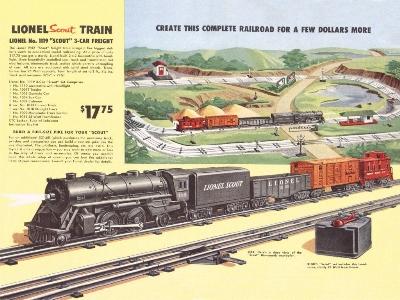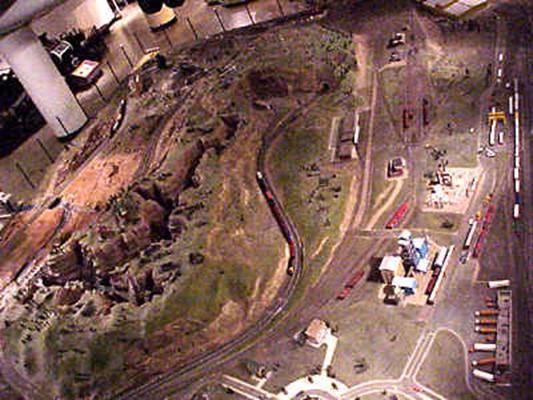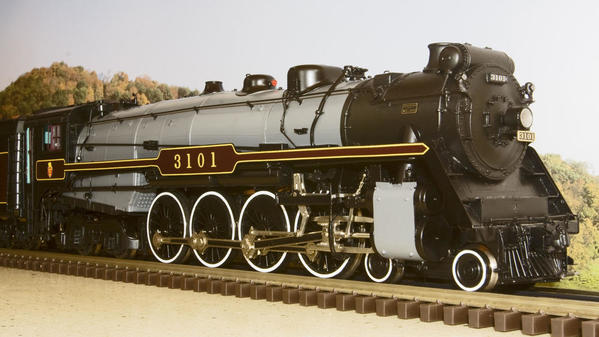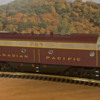Recently I've been thinking about my favorite era and the only era I model and collect in O scale the "transition era" between late super-power steam and early stylish first generation diesel power.
As I know most of you guys know I am not into the modern stuff at all. Actually if it's after 1950 my interest really fades.
Exposition Flyer 1945 in Nebraska
My passion expressed in the images I create and share here on OGR.
Newly delivered F7's on the Rio Grande 1949
I love the vibrant colorful paint work and design that graced the rails in the 1930's and 1940's....
Santa Fe E3 #11L and GS-2 #4410 both in 1941 detailing
My absolute favorite the gritty heavyweights and big high stepping steam!
Westbound Exposition Flyer with M68 and heavyweight consist 1944
Why am I not into the 1980's and 1990's or the newest trains? I'm not at all sure really.
As a boy in the 1980's I was introduced to trains with my father's Lionel Scout from 1952. My dad was 4 years old in 1952 however he had that neat little set. When I was able to go to my grandparents home in the early 1980's I ran into the basement and grabbed the trains.. Something about that Lionel black gondola and the Scout trucks intrigued me. In a way I have the same exposure to this hobby as a lot of the 3 Rail traditional guys on OGR just 30 years later.
My father bought me a book "ALL ABOARD!" By Ron Hollander. The public library in the kids section had a layout planning book that utilized the illustrated artwork found in the catalogs; Hollander's book reproduced a lot of art from the catalogs. I was hooked!
In the beginning I was given N Scale; this stuff was authentic and scaled like the real thing. Not like a lot of the Lionel post war I was intrigued with, N Scale looked like real trains. My family took me to Chicago around 1984 and when I saw the MSI's Museum & Santa Fe in original Kronkite with scale sized equipment I was on a mission and I've been addicted since.
Why O Scale? I like detail.. I like authenticity.. I like the size! I'm still struggling with OW5... I prefer P48
I also believe in too each their own and I enjoy seeing what you guys are doing with the various eras you model.
1940's Hotel
Early 50's Americana
1950's Hamburger Drive In
Industrial Rails modeling is so marvelous and his presentation is out of this world! He almost makes me want to grab a 1960's Penn Central ex-PRR E8 with filled port holes and dead flat black paint and weather the crap out of it! Maybe not.
Ed Rappe, John Sethian, you guys really make the hobby enjoyable for me.
I however I love seeing what everyone is doing here on OGR and I love sharing what I do.
My era ends absolutely in 1958 my latest piggyback cars are the only reason I have an SD9. Looking at my Piggyback train it's mostly the earliest variety of equipment mostly in the 1950-1955 time frame.
Otherwise it's PA's, Early E's, big steam, and beautiful long gleaming matched passenger trains. Love that- and that's me! Does it make me a jerk or a snob for having very little interest in anything after 1960 train wise? I hope not, but I seriously have little to no interest in modern railroading.
It's cool and one of my best friends is a "train driver" as they call them now for BNSF. But I don't know anything about the modern stuff after the 1970's . I'm lost. Very little. And I really don't want to. But I respect it and I respect those who like it.
I really enjoy you guys it's been a lot a fun!
What started it for you folks?
I am not a baby boomer born in 1975 I am not a Millennial either; I am the last age group you would expect to be into 1930's-1950's ..
Erik Lindgren: "transition era" 1930's to 1950's
PS: It may be worth mentioning that I have never lost my love for Post War Lionel and I am a dedicated collector of Lionel 1930's through 1957. Similar era to my Scale interests.





















